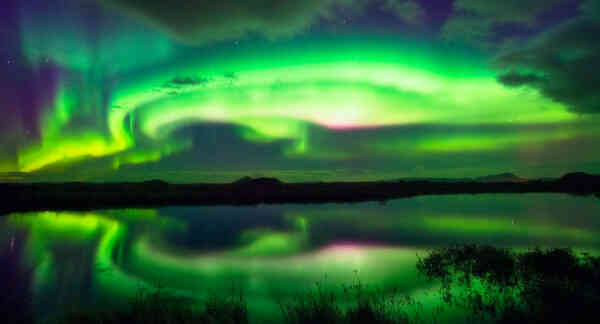The northern lights, more commonly referred to as the northern lights, are one of the most interesting natural phenomena. People have puzzled over what it is for centuries, until, finally, scientific minds have established what it is. Everyone who has seen the aurora with their own eyes will forever remember this incredible sight – as if a canopy of multi-colored airy fabric is swaying high in the night sky, or some aliens are arranging a grandiose laser show for earthlings.
Interesting facts about the aurora borealis
- Indigenous Eskimos have a legend that the aurora is the light falling from the windows of the heavenly palace in which the souls of the dead live.
- The first annalistic mention of the northern lights, which has come down to our days, was made in the 6th century BC.
- Aurora borealis occurs not only on Earth, but also on some other planets. On Jupiter, Saturn and Venus, for example, astronomers have already recorded it more than once.
- It can be observed both in the north and in the south. But due to the geographical remoteness of the South Pole, most often people go north for an unforgettable spectacle. Therefore, in fact, this natural phenomenon is usually called the northern lights (interesting facts about the South Pole).
- The aurora can only appear on a planet that has an atmosphere and its own magnetic field.
- In spring and in autumn, the northern lights can be observed more often than in winter and summer.
- On Earth, the auroras are most often observed at an altitude of about 110 kilometers, although the red glow is recorded at an altitude of up to 400 kilometers.
- In completely quiet, remote and deserted places, you can hear the sounds produced by the northern lights. These are muffled pops and crackles of static electricity. But a special technique is required, as our ear is not sensitive enough to hear sounds in this range.
- Due to solar storms, the northern lights have been observed very far from the poles several times, even in the subtropics. This phenomenon was recorded even in Texas (interesting facts about Texas).
- Archaeologists have discovered cave paintings made by primitive people and depicting the aurora. They are about 30,000 years old.
- The first scientist to study the northern lights was Galileo.
- The Vikings believed that the northern lights are a bridge between earth and heaven, along which the gods descend down to people.
- Especially bright the aurora borealis is very strong, giving almost as much light as the full moon.
- The northern lights appear not only at night, but also during the day, just in the daytime it is not visible to the naked eye.
- Among some indigenous peoples of the north, moreover, different people have a custom to arrange ritual dances and dances when the northern lights appear in the sky.
- The NASA space agency publishes forecasts of the northern lights on its website, based on the intensity of solar flares.
- In 1859, people could observe the brightest and longest northern lights in the history of civilization. It arose due to a powerful geomagnetic storm that lasted almost 5 days.
- On Venus, shrouded in dense clouds, the northern lights are sometimes so powerful that they cover almost the entire planet (interesting facts about Venus).
- On Saturn, flashes of aurora are recorded at an altitude of up to 1200 kilometers above the conditional surface. Conditional – because it does not have a solid surface, and the upper boundary of the dense layers of the atmosphere is taken as a reference point.
- The aurora sometimes lasts only 10-20 minutes, but sometimes it can be observed for 40-50 hours in a row.
- The highest northern lights above the Earth were recorded at an altitude of 643 kilometers.
- The color of the northern lights depends on which atmospheric gas is involved in its occurrence. Nitrogen, for example, gives purple flashes, and oxygen gives red ones.
- On board the ISS, astronauts are at the same height as the aurora, so they can see it «from the side» (interesting facts about the ISS).
- The strongest and brightest northern lights are observed during the peak of solar activity. The cycle of solar flares lasts approximately 11 years.
- Most often (up to 200-250 nights a year), the aurora can be observed in Alaska and Greenland.
- Under normal conditions, the northern lights have a length about 3 thousand kilometers. It depends on the magnetic field of our planet. During geomagnetic storms, this figure can increase greatly.
